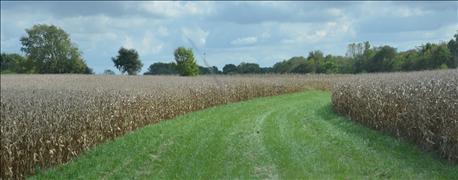
Combining corn had its frustrating moments in 2016. Disease in many areas led to lots of dust, down stalks, even orange clouds of spores where southern rust was a big factor and, for the most part, yields that weren’t quite what people expected. They varied all over the board, but so did expectations going into the season.
Seeing a scene like the one pictured below with a bright green waterway popping out before you as you crossed the field had to be refreshing. The corn looked like December, the waterway looked like June, and it was late September. Such was the 2016 season.

GREAT HARVEST SCENE: With disease and underperforming corn yields, there was stress at harvest this year. But scenes like this beautiful grass waterway viewed from the combine seat were refreshing.
How do you get and maintain a grass waterway like this one? This waterway is located on the farm that hosted the Crop Watch ’16 field. Here is a quick refresher on grass waterways. The Natural Resources Conservation Service outlines many considerations in the Grassed Waterway Program Job Sheet issued in 2006. Here are highlights. This article also refers to information in the Iowa Grassed Waterway Fact Sheet issued by NRCS staff in Iowa in 2012 as Iowa Practice 412.
1. Success starts with preparation.
The Iowa bulletin recommends removing trees, brush, stumps and other objectionable material from the site. This assumes you have notified authorities and know that whatever you do in this location will not violate any rules that would affect your participation in USDA programs. If fill material is needed, make sure it is free of frozen earth, brush and roots. Again, make sure you have checked with the proper authorities to know that you can use fill in this location.
2. Construct the waterway properly.
The Iowa bulletin suggests a parabolic design where the depth halfway to the center of the waterway is three-quarters of the depth at the center of the waterway. In Indiana, the maximum width for grass waterways where cost-share is involved is 100 feet. If topsoil is removed during construction, it should be stockpiled and replaced after construction is finished.
3. Seed to establish the waterway.
In Indiana, NRCS recommends no-till seeding to reduce erosion and possible loss of seedlings. If you’re planting native grasses, make sure the drill is equipped to handle the seed. A seeding depth of no more than one-quarter inch is especially critical for native grasses.
If seeding conventionally, use a drill with spacing no wider than 7 inches or a cultipacker seeder. Work to a minimum depth of 3 inches, and firm before seeding. Seed grass seed uniformly, and no more than one-half inch deep, according to the Indiana NRCS bulletin.
If broadcast seeding, one option is mixing seed with 200 pounds per acre of pelletized lime and applying with an airflow applicator. Cultipack before and after seeding. It’s acceptable to see half the seed on the surface.
Iowa specifications allow for mulching the waterway after seeding and making one trip with a straight disk to anchor it. If you are receiving cost-share for the practice, make sure to follow the rules outlined by your local NRCS office.
4. Administer proper maintenance, herbicides and mowing.
If it is a cost-share waterway with NRCS in Indiana, you can burn, mow or apply herbicides as needed to control unwanted vegetation until a final status review is completed, or for a maximum of three years after planting. Mow when weeds are taller than the planted vegetation.
Once the waterway is approved in a final status review, mowing and other maintenance activities are prohibited between April 1 and Aug. 1 to protect nesting wildlife. The county Farm Service Agency committee may approve spot treatment of weeds during the nesting season. However, be sure you have approval for the maintenance activity before completing it.
About the Author(s)
You May Also Like




